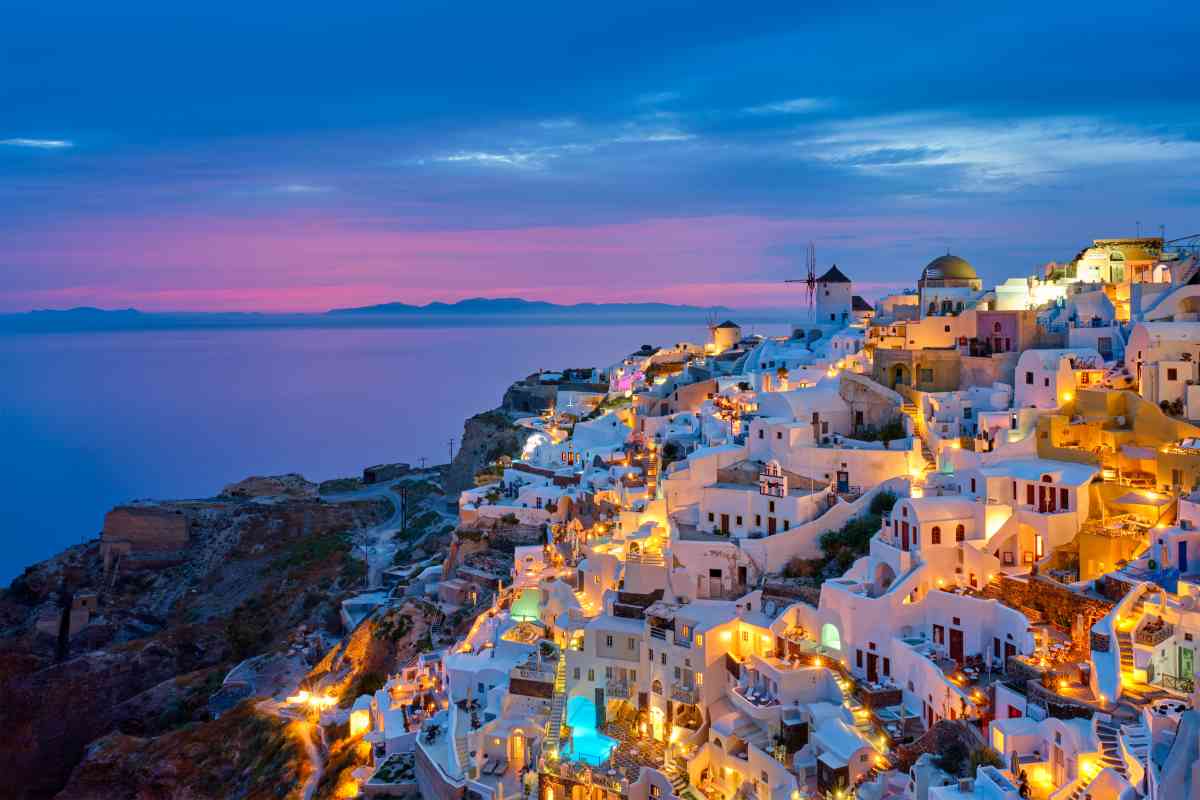1. Temple of Apollo Epicurius at Bassae (1986)
In Bassae, Peloponnese, the Temple of Apollo Epicurius is breathtakingly beautiful. This sanctuary was built between 450 and 400 BC by Iktinos and is situated 1,131 metres above sea level. However, you must note that Charles Robert Cockerell, a British archaeologist, removed several significant friezes in 1815 and took them to the British Museum.
- Location: Figaleia 270 61, Greece
- Ideal Time to Explore: May to October
- Hours of Operation: 8:30 AM – 3:30 PM
- Entry Fee: € 3 to € 6 per person
2. Acropolis of Athens (1987)
The Parthenon, the Propylaea, the Erectheion, and the Temple of Athena Nike make up the Acropolis, which is perched atop a cliff above the city. This structure was constructed during the Golden Age of Athens in the fifth century BC. Many pieces of the Parthenon Temple were removed by the British Lord Elgin in 1816, and he eventually sold them to the British Museum.
- Location: Athens 105 58, Greece
- Ideal Time to Explore: May to October
- Hours of Operation: 8 AM – 8 PM
- Entry Fee: € 24.50 per person
3. Archaeological Site of Delphi (1987)
The Ancient Delphi is situated near the middle of mainland Greece. Also, the god Apollo is linked with the entire site. Due to its function as a site of union for the local city-states, ancient Delphi also played a political function. The Delphi Archaeological Museum is located below the archaeological site.
- Location: Delphi 330 54, Greece
- Ideal Time to Explore: May to October
- Hours of Operation: 8:30 AM - 3:30 PM
- Entry Fee: Varies between € 3 to € 20 per person
4. Sanctuary of Asclepius at Epidaurus (1988)
As Epidaurus was regarded as the birthplace of the god, the Sanctuary of Asclepius in Epidaurus, eastern Peloponnese, was a very significant healing centre in antiquity. Patients would travel to Epidaurus from all over the Mediterranean to receive a cure that is caused by the visions of god. Also, the Ancient Theatre of Epidaurus is now well-known worldwide.
- Location: Epidavros Municipality 210 52, Greece
- Ideal Time to Explore: May to October
- Hours of Operation: 8 AM to 5 PM from November to March
- Entry Fee: € 6 per person
5. Medieval City of Rhodes (1988)
The Knight Order of Saint John of Jerusalem, who resided on the island from 1309 until 1523, built the Medieval City of Rhodes in its current shape. The Ottomans and the Italians who later inhabited the town also left their imprints on it. The Palace of the Grand Masters, the Great Hospital, and the Street of the Knights are notable examples of Gothic architecture in the Upper Town.
- Location: Rhodes Town 85100, Greece
- Ideal Time to Explore: May to October
- Hours of Operation: 8 AM to 8 PM from April to October
- Entry Fee: € 5 per person
6. Meteora (1988)
Meteora is situated on the northwest coast of mainland Greece. The rocks of this place are conglomerate and sandstone. In the thirteenth century AD, monks constructed these monasteries atop these rocks. However, only six of the 24 monasteries that had stood atop Meteora are still active today.
- Location: Kalabaka 422 00, Greece
- Ideal Time to Explore: May to October
- Hours of Operation: 9:00 AM to 4:00 PM, 9:30 AM to 4:00 (Sundays)
- Entry Fee: € 3 per person
7. Mount Athos (1988)
The monastic community of Mount Athos occupies the eastern peninsula of Halkidiki in northern Greece and is also considered to be an independent monastic state. Since the Byzantine era, Mount Athos has served as an Orthodox spiritual centre since 1054 and has had an independent statute. Here you can witness impressive monasteries with significant artistic value built for many ages.
- Location: NA
- Ideal Time to Explore: May to October
- Hours of Operation: 05:30 AM to 01:00 PM (Monday to Friday), 06:30 AM to 01:00 PM (Saturday) and 08:00 AM to 01:00 PM (Sunday).
- Entry Fee: €18 (Orthodox visitors); €30 (non-Orthodox); €10 (non-Orthodox but student).
8. Byzantine Monuments of Thessaloniki (1988)
Thessaloniki was the second-most significant town in the Byzantine Empire for many centuries and was crucial to the spread of Christianity in the Balkans. Many of these churches and other structures from that period are listed as UNESCO World Heritage Sites, including the Rotonda of Saint George, the Church of Saint Nicolas Orfanos, etc.
- Location: Thessaloniki
- Ideal Time to Explore: May to October
- Hours of Operation: 8.30 AM to 03.00 PM
- Entry Fee: € 4 from 1st November to 31st March and € 6 from 1st November to 31st March
9. Archaeological Site of Olympia (1989)
In the western Peloponnese, Olympia's location is built along the Alpheios River. To celebrate the god Zeus or the legendary hero Hercules, the ancient Olympic Games were first held here in 776 BC. The Philippeion, the Philippeus, the Hera Temple, the Temple of Zeus, and the Ancient Stadium are all significant Olympian landmarks.
- Location: Archaia Olympia 270 65, Greece
- Ideal Time to Explore: May to October
- Hours of Operation: 8.00 AM to 03.00 PM
- Entry Fee: € 6 to € 12 per person
10. Archaeological Site of Mystras (1989)
During the latter years of the Byzantine Empire, this fortified town of Mystras was very crucial. The final Byzantine Emperors (the Paleologos line) were born in this town, which was built on the steep summit of Mount Taygetos. It was also the last Byzantine bastion to be conquered by the Ottomans. You can also visit the Palace of Despots, located at the summit of the hill.
- Location: Lower Town 231 00, Greece
- Ideal Time to Explore: May to October
- Hours of Operation: 8:30 AM to 3:30 PM
- Entry Fee: € 12 per person
11. Delos (1990)
Greek mythology describes Delos as the island where the god Apollo was born. For this reason, the entire island was devoted to Apollo, and pilgrims would travel from all across the Mediterranean to venerate him. In the fifth century BC, Delos became more than just a centre of religion. The island is a public archaeological site with numerous intriguing monuments and a small museum. However, it is not currently inhabited.
- Location: Delos (Archipelago: Cyclades)
- Ideal Time to Explore: May to October
- Hours of Operation: Not Found
- Entry Fee: € 12 per person
12. Monasteries of Daphni, Osios Loukas and Nea Moni (1990)
Although these monasteries are far apart from one another, they were built in the same architectural style and share similar aesthetic qualities. The churches were constructed with a huge dome and a cross-in-square layout. They were embellished with marble artwork and mosaics on a gold background throughout the 11th and 12th centuries, which is considered the second golden age of Byzantine art.
- Location: Iera Odos, Chaidari 124 61, Greece
- Ideal Time to Explore: May to October
- Hours of Operation: 8:30 AM to 3:30 PM
- Entry Fee: No entry fee
13. Pythagorion and Heraion of Samos (1992)
The ruins of the old city and the Eupalinus aqueduct provide evidence of Pythagorion's importance during the Classical and Roman periods. Originally built in the eighth century, Heraion was partially destroyed in the sixth century BC. It underwent numerous reforms in the next years, particularly under the influence of the Romans.
- Location: Pythagoreio 831 03, Greece
- Ideal Time to Explore: May to October
- Hours of Operation: 8:30 AM to 3:30 PM
- Entry Fee: € 2 to € 4 per person
14. Archaeological Site of Aigai (Modern Vergina) (1996)
The original capital of the Macedonian kingdom was the ancient city of Aigai. When the tomb of Phillip II, father of Alexander the Great, and other Macedonian rulers was found in 1977, the site rose to fame on a global scale. You can witness the famed golden crown of Phillip as well as other amazing artefacts in the excellent Vegina museum.
- Location: Vergina, 590 31, Greece
- Ideal Time to Explore: May to October
- Hours of Operation: 9:00 AM to 5:00 PM
- Entry Fee: € 12 per person
15. Monastery of Saint John and Cave of Apocalypse in Patmos (1999)
The Monastery of Saint John the Theologian, the Cave of Apocalypse, and the charming village of Chora in Patmos are all on the UNESCO list. The Monastery of Saint John was founded in the final decades of the tenth century, and it is still a famous religious destination today.
- Location: Patmos 855 00, Greece
- Ideal Time to Explore: May to October
- Hours of Operation: 8 AM to 1:30 PM
- Entry Fee: € 6 per person
16. Archaeological Sites of Mycenae and Tiryns (1999)
On the eastern side of the Peloponnese, Mycenae and Tiryns are situated close to one another. In this regard, the Trojan War and the town of Mycenae have a close relationship. It inspired numerous other Greek towns to be built in the same manner and gave its name to an entire culture, the Mycenaean civilisation.
- Location: Mykines 212 00, Greece
- Ideal Time to Explore: May to October
- Hours of Operation: 8 AM to 8 PM
- Entry Fee:€ 6 to € 12 per person
17. Old Town of Corfu (2007)
The most recent Greek monument to be added to the UNESCO List is the Old Town of Corfu. The Old Town of Corfu, which had two strongholds and a strong Venetian impact on its architecture, served as the island's defence against pirates and invasions during the Middle Ages. The most recognisable part of the town is Liston Avenue, and Spianada Square is the second-largest square in all of Europe after Saint Marc Square in Venice.
- Location: Agios Spyridonos, Kerkira 491 00, Greece
- Ideal Time to Explore: May to October
- Hours of Operation: 8 AM to 9 PM
- Entry Fee: € 2 to € 4 per person
18. Archaeological Site of Philippi (2016)
Philip II of Macedon founded this place in 356 BCE, and it is the latest inclusion in the Greece UNESCO sites. Also, in 42 BCE, this city was a part of the Battle of Philippi. The Romans reconstructed this place as a "small Rome" by introducing public constructions. In 49–50 CE, after the visit of the Apostle Paul, this city also became a hub of Christianity.
- Location: EO Dramas Kavalas, Filippi 640 03, Greece
- Ideal Time to Explore: May to October
- Hours of Operation: 8 AM to 3.30 PM
- Entry Fee: € 3 to € 6 per person













 Tools & Calculators
Tools & Calculators


 Logout
Logout








